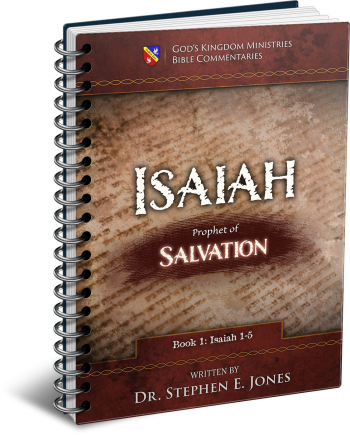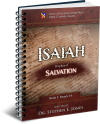Latest Posts
View the latest posts in an easy-to-read list format, with filtering options.

Isaiah is the prophet of Salvation. He is also known as the truly "Universalist" prophet, by which is meant that He makes it clear that salvation is extended equally to all nations and not just to Israel. He lived to see the fall of Israel and the deportation of the Israelites to Assyria, and he prophesied of their "return" to God (through repentance). He is truly a "major prophet" whose prophecies greatly influenced the Apostle Paul in the New Testament.
Category - Bible Commentaries

When “the Branch of the Lord” comes, bringing the fruit of the Kingdom (Isaiah 4:2), the results will be glorious. Isaiah 4:3 says,
3 It will come about that he who is left in Zion and remains in Jerusalem will be called holy—everyone who is recorded for life in Jerusalem.
The prophet proclaims that the surviving remnant in “Zion” and “Jerusalem” will be “holy.” However, like all of the other prophets, Isaiah does not distinguish between the two Jerusalems. He implies that these “holy” ones will be few, as in the aftermath of a war. These few are “recorded for life,” that is, their names are written down and recorded as being alive.
This is a reference to the Book of Life mentioned in Psalm 69:28; Phil. 4:3; Rev, 13:8, 17:8, 20:12, 15; 21:27. It is clearly the heavenly record of righteous people who either have immortality or are worthy of such a reward.
This Book of Life is first mentioned by Moses in Exodus 32:31-33, when Moses interceded for the Israelites after they had worshiped the golden calf:
31 Then Moses returned to the Lord, and said, “Alas, this people has committed a great sin, and they have made a god of gold for themselves. 32 But now, if You will, forgive their sin—and if not, please blot me out from Your book which You have written!” 33 The Lord said to Moses, “Whoever has sinned against Me, I will blot him out of My book.”
When Isaiah prophesied that the surviving remnant would be “recorded for life in Jerusalem,” we should understand that these are the overcomers whose names are written in the Book of Life, not in the earthly Jerusalem but in the heavenly Jerusalem.
Every city had an official record of its living inhabitants, but this is God’s heavenly census of immortals whose “citizenship is in heaven” (Phil. 3:20).
Many have interpreted Isaiah 4:3 in terms of a final war against the earthly Jerusalem during a time of “tribulation.” They believe that the war will go so badly that only a few will survive, and that Christ will then come to save Jerusalem from utter destruction. They say that when the survivors in Jerusalem see Him coming, they will somehow recognize Him as Jesus Christ and will then be converted.
That view, though popular today among Christians, does not believe the prophecy in Jer. 19:10, 11, where the prophet says that Jerusalem will be utterly destroyed in such a way that it can never be repaired (or rebuilt) again. Neither do such people believe the prophet who says that the glory of God would leave Jerusalem and its temple even as it had left Shiloh a few centuries ago (Jer. 7:12-14). The glory never returned to Shiloh; neither will it return to Jerusalem, for it has moved on to a new temple built with living stones that Christ Himself is now building (Eph. 2:20-22).
We must interpret Isaiah 4:3 in a way that does not contradict Jeremiah’s prophecies. The New Testament does this by distinguishing the two Jerusalems. Paul says specifically that the earthly Jerusalem is “Hagar” (Gal. 4:25) and its inhabitants are children of flesh (Gal. 4:29; Rom. 9:8; i.e., prophetic “Ishmaelites”) who must be “cast out” (Gal. 4:30). These, Paul says, are not chosen as heirs with the “Isaac” company (Gal. 4:30).
Many Jews hate the Apostle Paul for his teachings and have convinced many Christians to reject his views as well, preferring to make non-believers “chosen” through fleshly genealogy. But if fleshly genealogy could make a man “chosen,” why then were only 7,000 Israelites chosen in the time of Elijah? Paul limits “chosen” status to a small remnant of grace (Rom. 11:5-7) which can be of any ethnic background. Peter, too, discovered to his surprise that God was impartial in dispensing the Holy Spirit that God had promised to Israel (Acts 10:34, 35).
Isaiah 4:3 was an end-time prophecy of “the Branch of the Lord” (i.e., the Messiah) and His mission. In His first appearance, the earthly Jerusalem rejected His rule and were judged accordingly 40 years later (30-33 to 70-73 A.D.). His second coming will be to benefit the people of the New Jerusalem, the true chosen people. The dead overcomers will be raised in the first resurrection (Rev. 20:4-6), and those who are living at the time will be changed into His image (1 Cor. 15:51, 52).
These are the ones whose names are “recorded for life in Jerusalem” (Isaiah 4:3). They are the citizens of the New Jerusalem, not the children of flesh living in the earthly Jerusalem.
Isaiah 4:4 says,
4 When the Lord has washed away the filth of the daughters of Zion and purged the bloodshed of Jerusalem from her midst, by the spirit of judgment and the spirit of burning…
John the Baptist interpreted this in Matt. 3:11, 12,
11 As for me, I baptize you with water for repentance, but He who is coming after me is mightier than I, and I am not fit to remove His sandals; He will baptize you with the Holy Spirit and fire. 12 His winnowing fork is in His hand, and He will thoroughly clear His threshing floor; and He will gather His wheat into the barn, but He will burn up the chaff with unquenchable fire.”
The purpose of the Holy Spirit’s baptism is to burn the flesh, here pictured as “chaff.” John’s farming metaphor separates chaff from the wheat in order to burn the chaff and store the grain that can be used for food. On an individual level, the Holy Spirit leads us as with Israel in the wilderness in the pillar of fire, and each time we put down the desires of the flesh and follow His leading, more flesh is burned.
On a broader prophetic level, the earthly Jerusalem, with its children of flesh, are being treated as chaff to separate them from the remnant of grace who are truly God’s chosen elect. For this reason, John the Baptist spoke also of “the axe” that was being readied to chop down the unfruitful fig tree of Judah and Jerusalem (Matt. 3:10).
Isaiah also tells us that “the Lord has washed away the filth of the daughters of Zion and purged the bloodshed of Jerusalem.” While many interpret this to mean that God will cleanse and save the earthly Jerusalem and its fleshly inhabitants at the last minute, that is not what Isaiah was saying. The remnant itself was corrupt and imperfect and in need of cleansing.
The word “remnant” (she’ar) also means “leaven.” The Hebrew root word is sha’ar, a verb from which is derived she’ar (“remnant”) and sehore (“leaven”). The overcoming remnant does not start out as righteous but as fleshly people through their descent from Adam and perhaps also from Abraham. The purpose of the Holy Spirit is seen in the Pentecostal instruction in Lev. 23:17, where the two loaves of leavened wheat are to be baked in the fire of the Holy Spirit to kill the leaven, thereby making it an acceptable offering.
The prime example of leaven is found in the story of Manasseh, son of Hezekiah, who fulfilled Isaiah’s prophecy in 2 Kings 19:30, 31,
30 The surviving remnant of the house of Judah will again take root downward and bear fruit upward. 31 For out of Jerusalem will go forth a remnant, and out of Mount Zion survivors. The zeal of the Lord of hosts will perform this.
This prophecy was fulfilled by Manasseh, who was a wicked king at first. God then caused him to go into captivity, where he was put into a Babylonian dungeon until he repented of his wickedness (2 Chron. 33:11-13). He was then restored to his throne and became a godly king. He is the prime prophetic type of the remnant being washed of filth and purged of bloodshed.
That is how we must interpret Isaiah 4:4. God has been purging a remnant for the past 2,000 years through the baptism of the Holy Spirit, as John prophesied. Those who qualify as the cleansed remnant will be raised in the first resurrection at the end of the present age when “the Branch of the Lord” comes to deliver them.
Isaiah 4:5, 6 says,
5 then the Lord will create over the whole area of Mount Zion and over her assemblies a cloud by day, even smoke, and the brightness of a flaming fire by night; for over all the glory will be a canopy. 6 There will be a shelter to give shade from the heat by day and refuge and protection from the storm and the rain.
Isaiah tells us that the pillar of fire and the pillar of cloud, which led Israel in the wilderness under Moses, prophesied of a future time as well. We need not take this in a literal manner, of course, for the pillar of fire is the manifestation of the Holy Spirit. The pillar of fire appeared upon the heads of the disciples in the upper room who were filled with the Holy Spirit on the day of Pentecost (Acts 2:1-3).
This was the beginning of the fulfillment of Isaiah 4:5. In other words, the 120 disciples were the new “Mount Zion” over which the pillar of fire was visible, and the glory of God became their canopy. Just as there are two Jerusalems, one fleshly and the other spiritual, so also are there two Mount Zions. As we have already shown, the new Mount Zion is actually Mount Sion (Hermon), the place where Jesus was seen as the manifested Son of God.
Isaiah thus prophesies that those who are filled with the Spirit are the sons of God radiating the glory of God’s presence.
Not only are they protected “from the storm and the rain,” but they are also a city of refuge for sinners who are in need of protection. The six cities of refuge that were set up under Moses and Joshua represent not only Christ but His body of overcomers as well (Num. 35:14; Joshua 20:2).